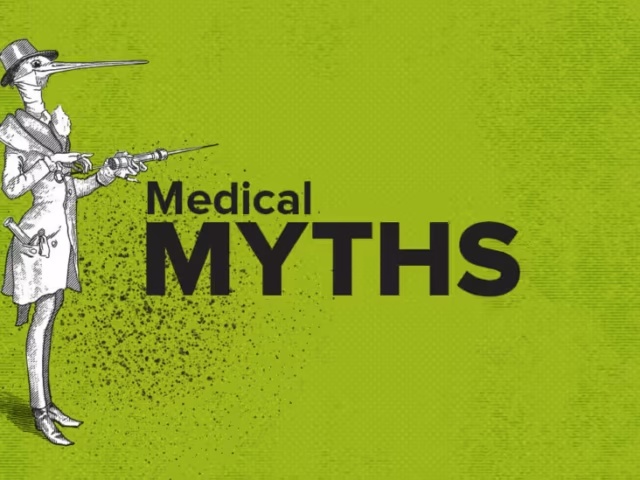
Written by Tim Newman and Maria Cohut, Ph.D. — Fact checked by Jill Seladi-Schulman, Ph.D.
Around 300,000 generations ago, the human species split from an ancient ancestor that we share with chimpanzees. Since then, human life expectancy at birth has doubled.
Over the last 200 years, life expectancy at birth has doubled again. As animals go, humans perform well in longevity.
According to the World Health Organization (WHO), “between 2000 and 2050, the proportion of the world’s population over 60 years will double from about 11% to 22%.”
With these facts in mind, dispelling the many myths associated with aging seems more pressing than at any point in our evolutionary history. In this article, we will tackle myths associated with exercise, cognitive ability, sex, and more.
This is not entirely untrue. As we age, our body does experience wear and tear from decades of use. However, physical deterioration does not have to be complete, and people can often slow it down.
Time and again, research has suggested that engaging in regular exercise and following and healthy diet can help people live longer lives by fighting or preventing the physical problems that appear with age.
Some research suggests that merely expecting physical deterioration increases the likelihood that someone will physically deteriorate.
In one studyTrusted Source, scientists surveyed 148 older adults about their aging, lifestyles, and general health expectations.
They concluded that expectations regarding aging “play an important role in the adoption of physically active lifestyles in older adults and may influence health outcomes, such as physical function.”
So, although some deterioration is likely, managing expectations will help individuals make better life choices to maintain physical health and fitness later in life.
A 2024 review of the existing literature investigated how perceptions of aging influenced an individual’s likelihood of seeking medical attention. The authors of the review, which included data from 12 studies totalling 3,664 participants between them, noted that:
“[O]lder adults with lower aging expectations would be less likely to believe that it is important to seek health care for age-associated conditions such as depression, memory impairment, and urinary incontinence.”
At the same time, a studyTrusted Source looking at older adults in China, sought to investigate how individual attitudes to aging might influence death risk in this cohort.
The authors concluded that “a more positive [self-perception of aging] is associated with a lower risk of all-cause mortality,” suggesting that ”this association is partly mediated by healthy lifestyle behaviors and social participation.”
In short, keeping active, eating right, having an active social life, and maintaining a positive outlook could help slow down the physical deterioration associated with older age.
2. Older adults should avoid exercise
Some people think that, once they reach a certain age, there is no point in exercising, as they believe that it will provide no benefit. This is another myth.
An increasing amount of evidence uncovered by recent studies supports the notion that keeping active as we grow older can maintain cardiometabolic fitness and brain health.
In one study, researchers divided 451 older adults into three groups:
- the first group underwent 1 year of heavy resistance training
- the second participated in moderate-intensity training for the same amount of time
- the third group did not exercise, acting as the control group.
The scientists found that the older adults who had undertaken heavy resistance training for 1 year were better able to maintain muscle strength than peers in the other groups, even 4 years after the initial study period.
There is also good evidence that regular exercise can reduce the risk of developing Alzheimer’s disease and other forms of dementia.
Two recent studies analyzed data from the EXERT studyTrusted Source, a clinical trial looking at the effects of regular low-intensity compared to moderate-to-high intensity exercise on cognitive function over 12 months in older sedentary adults with mild cognitive impairment.
The studies found that both low- and moderate-to-high intensity exercise regimens were associated with less brain volume loss over 12 months.
Nevertheless, people should consult their doctor before embarking on a new exercise regime if they have a medical condition.
For example, the National Health Service (NHS) in the United Kingdom indicate that people with a high fracture risk or spinal fractures linked to osteoporosis may wish to avoid some forms of high-impact exercise.
At the same time, the “Global consensus on optimal exercise recommendations for enhancing healthy longevity in older adults (ICFSR)”, published in January 2025, indicates that some form of exercise is recommended to everyone who wants to live a healthy, longer life.
For example, the authors of the “Global consensus” note, “brisk walking for up to 75 min per week extended life expectancy by 1.8 years compared with no activity.”
3. Older adults need less (or more) sleep
Some people believe that older adults need more sleep than younger adults, perhaps because of the stereotype that older people enjoy a nap. Others say that older adults need less sleep, which might stem from the stereotype that older adults rise early in the morning.
These myths are relatively difficult to unpick because there are many factors involved. It is undoubtedly true that older adults have more difficulty getting to sleep and that their sleep tends to be more fragmented.
This might help explain why some older adults need to nap in the day. As the human body changes with age, it can disrupt the circadian (daily) rhythms.
This, in turn, can impact sleep. The relationship is multifaceted, too: If a person’s circadian rhythms become disrupted, it can influence other aspects of their physiology, such as hormone levels, which might also impact their sleep.
Aside from circadian disruptions, certain diseases that occur more commonly in older adults, such as osteoarthritis and osteoporosis, can cause discomfort, which might adversely influence an individual’s ability to get to sleep or stay asleep.
Similarly, some conditions cause shortness of breath, including chronic obstructive pulmonary disease (COPD) and congestive heart failure. These can also make sleeping more challenging. COPD, for instance, is known to cause fatigue.
According to existing researchTrusted Source, certain medications, including beta-blockers, bronchodilators, corticosteroids, some decongestants, and diuretics can also interfere with sleep. Older adults are more likely to be taking these types of medication, sometimes together.
The Centers for Disease Control and Prevention(CDC)Trusted Source state that people aged 61–64 need 7–9 hours, and people aged 65 or older need 7–8 hours of sleep each night. It just might be more difficult for them to get that all-important shut-eye.
As a silver lining, some research suggests that older adults can handle sleep deprivation better than young adults. A study published in the Journal of Sleep ResearchTrusted Source in 2018 found that older adults scored better following a sleep deprivation intervention than younger adults in a range of measures, including negative affect, depression, confusion, tension, anger, fatigue, and irritability.
4. Only women get osteoporosis
Osteoporosis is a condition where bones gradually become weaker. Some people believe that it only affects women. This is not true; it can affect either sex and people of any age. However, osteoporosis is indeed much more common in older people, white people, and females.
According to International Osteoporosis Foundation estimates, globally, around one in three women over 50 have osteoporosis, and about one in five men will experience a bone fracture related to osteoporosis in their lifetime.
Another related myth is that osteoporosis is inevitable for women as they age. As the figures above attest, two-thirds of women over 50 do not have osteoporosis.
To minimize risks, the National Institute on AgingTrusted Source advise people to eat foods rich in calcium and vitamin D and exercise regularly.
5. As you age, your brain slows
The term “cognitive decline” refers to a gradual decrease in mental functioning with age, but before we tackle the facts of the matter, we dismiss a couple of associated myths:
Dementia is inevitable as you age
According to the WHO, the risk of developing dementia increases with ageTrusted Source but it does not affect all older adults. The latest available WHO data, from 2021, indicates that 57 million people around the world live with dementia.
Further, data from the Alzheimer’s Society in the United Kingdom indicates that the prevalence of late-onset dementia in the U.K. population is of 0.9% for those aged 60–64 years, 1.7% for those aged 65–69 years, and 3% for those aged 70–74 years, meaning that a significant proportion of the aging population does not experience this condition.
According to a nationally representative study conducted by researchers from Columbia University and published in 2022, in the United States, approximately 10%Trusted Source of adults aged 65 and older have dementia, which means that around 90% are dementia-free.
Cognitive decline leads to dementia
Contrary to popular opinion, cognitive decline does not necessarily signal the start of dementia.
People who go on to develop dementia tend to experience cognitive decline first. However, not everyone who experiences cognitive decline will develop dementia.
The same nationally representative study from Columbia University found that approximately 22% of U.S. adults aged 65 or older have mild cognitive impairment.
Cognitive decline is inevitable
As the previously cited statistics show, cognitive decline is not inevitable, regardless of the long-held myth that older adults experience a mental slowing down. And, importantly, there are ways to reduce the risk.
In 2024, a Lancet CommissionTrusted Source report identified 14 modifiable risk factors for dementia and cognitive impairment. These are:
- education level
- existence of a head injury
- levels of physical activity
- smoking habits
- alcohol consumption
- hypertension (high blood pressure)
- cholesterol
- obesity
- diabetes
- hearing loss
- vision loss
- depression
- levels of social contact
- exposure to air pollution.
Acting to remove or mitigate the impact of these factors can help reduce a person’s risk of cognitive decline, the Lancet Commission report indicates.
6. There’s no point giving up smoking now
Whether this is a genuine myth or merely an excuse, some older adults say that there is no point in giving up smoking at “their age.” This is not true. As the NHS clearly explain:
“When you quit smoking, good things start to happen. You’ll begin to see almost immediate improvements to your health. It’s never too late to quit.”
7. Sex is rare or impossible as you age
Some people believe that older adults lose their ability to enjoy sex and that their sexual organs become unfit for purpose. This, thankfully, is a myth.
It is true that the risk of erectile dysfunction (ED) and vaginal dryness increases as people age, but for most individuals, these are not insurmountable problems.
Sildenafil (Viagra) and lubricants or hormone creams can work wonders in many cases. Before taking Viagra, though, it is essential to speak with a doctor, as it is not suitable for everyone.
An article published in the International Journal of Clinical PracticeTrusted Source in 2017 indicates that around 0.4% of men aged 18–29 experience ED, compared with 11.5% of men aged 60–69. However, flipping that statistic on its head makes it much less daunting — almost 9 out of 10 men in their 60s do not have ED.
Intercourse between older people may be less fast and furious, but that is not necessarily a bad thing. As one researcher writes, “growing old does not necessarily discontinue a healthy sexual life, but it does call for redefining its expression.”
There are certain benefits, too. For instance, a male’s penis often becomes less sensitive, helping them maintain an erection longer.
It is true that as some people grow older, they do not have the same sexual desire or drive as when they were young, but this is by no means the case for everyone.
However, according to a study conducted in the U.K. and published in 2016, which involved more than 6,000 adults, both female and male, aged 50 and over, 86% of male and 60% of female participants in the 60–69-year-old bracked reported being sexually active.
As many as 59% of men and 34% of women aged 70–79 years said the same, and 31% of men and 14% of women aged 80 years or older declared they still enjoyed an active sex life.
The takehome
Overall, most of the myths surrounding age seem to center on inevitability. People believe that it is inevitable that they will gradually crumble into dust as their lives become increasingly unbearable, boring, passionless, and painful.
Although certain aspects of health might decline with age, none of the above is inevitable for everyone. As we have discovered, a positive psychological outlook on aging can benefit the physical aspects of aging.
Disclaimer
The information contained in South Florida Reporter is for general information purposes only.
The South Florida Reporter assumes no responsibility for errors or omissions in the contents of the Service.
In no event shall the South Florida Reporter be liable for any special, direct, indirect, consequential, or incidental damages or any damages whatsoever, whether in an action of contract, negligence or other tort, arising out of or in connection with the use of the Service or the contents of the Service. The Company reserves the right to make additions, deletions, or modifications to the contents of the Service at any time without prior notice.
The Company does not warrant that the Service is free of viruses or other harmful components












